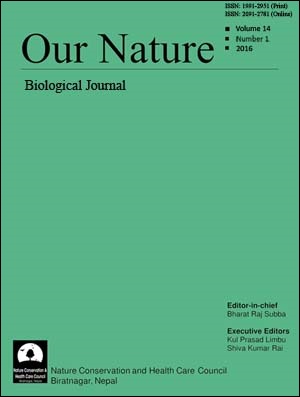Water quality and red bloom algae of fish ponds in three different regions of Nepal
DOI:
https://doi.org/10.3126/on.v14i1.16443Keywords:
Conductivity, Euglenophytes, Fish production, PhytoplanktonAbstract
Present study determines the causes and seasonal variation of red bloom in fishponds of Eastern, Western and Central regions of Nepal. Monthly monitoring of water quality and phytoplankton was carried out for one year. Water parameters such as NH3-N, total phosphorus, total Kjeldahl nitrogen (TKN), total dissolved solids (TDS) and conductivity were significantly higher (p<0.05) in red bloom fishponds than non-red bloom fishponds. The total density of euglenophytes in red-bloom fishponds was significantly higher (P<0.05) (1970±260 cells L-1) than non-red bloom fishponds (410±30 cells L-1). Euglenophyte density varied seasonally and significantly lower in spring season (1250±220 cells L-1) than autumn (1950±390 cells L-1), winter (2180±370 cells L-1), and summer (2490±480 cells L-1) in red bloom fishponds. High nutrients might favor the growth of euglenophytes (Euglena sanguinea) causing red bloom fish ponds of Nepal.

This work is licensed under a Creative Commons Attribution-NonCommercial 4.0 International License.
Downloads
Downloads
Published
How to Cite
Issue
Section
License
This license enables reusers to distribute, remix, adapt, and build upon the material in any medium or format for noncommercial purposes only, and only so long as attribution is given to the creator.




